Eurotour 2012 Part 2, Scandic.
After the Austrian Cup final, it was a straight forward but lengthy change to get to Denmark, the overnight train from Vienna to Hamburg takes more than 12 hours, and then with a further change at Fredericia, one arrives at Randers with over 20 hours on the rails. As with my arrival in Austria, this meant I was in town about three and a half hours before kick-off. I had found a hotel in the town centre, at slightly less than seriously overpriced. I took the chance to wander slightly around the town centre. It is compact, and has few old style buildings, but it is never going to become a tourism hot spot.
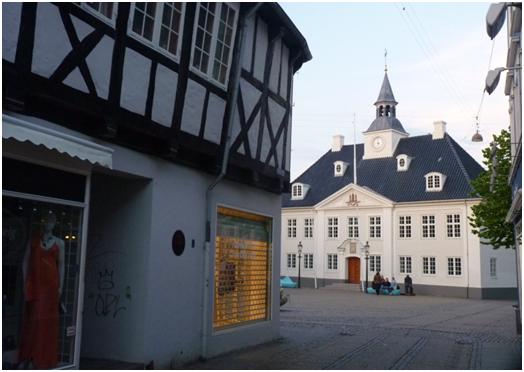
The Randers Stadion, (now officially the AutoC Park) is conveniently only about ten minutes walk from the railway station. The hotel was 15 minutes walk from the station. Naturally we are talking opposite directions! The stadium has a modern feel to it, thanks to new stands and a very modern metal lattice work cladding these. However, once you enter, you find that the north end is steps of very unreconstructed terracing, without even the benefit of a few safety barriers. Most of this was not in use though, with one corner housing a few home fans, and another taken by the small number of travelling fans. A few low steps carry on around most of the rest of the stadium, probably the remnants of the old terraces, but renovated, and mainly converted into seats. There is still a terrace for about three quarters of the length behind the south goal, and this is where the popular support stands. A small group however take a block of the stand above for singing and the waving of flags. The new stands have been built above and behind the old ones, raised up by steel girders, so as at its closest point, it is some three meters above access to the seats. The main stand maintains a common height and roof line with the East and South sections. This stand as a single tier and is backed by a massive glass wall behind which are two levels. As far as I could see, the lower one of these was a VIP lounge, while above there were even more exclusive executive boxes, broken only in the very centre for the TV camera gantry.
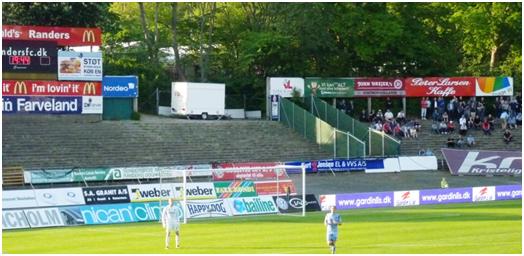
Live television has created a series of Monday night games in the Danish 1st Division, (which like the Austrian 1. Liga is actually the second division). The division has 12 teams playing a 26 game season, and two places in the Superliga up for grabs. As the Monday night game, the two teams I was watching had a game extra to play, while most of the league had four games to go. Esbjerg, for some reason had played an extra game, and this gave them a lead confirming their place as champions. Randers started the night in second (and had to finish it the same way as this was the only game), with a three point lead over Vejle-Kolding and Viborg, five over Bronshoj. The visitors, Vestsjaelland are mid table, five points ahead of the highest relegation place, so relatively safe.
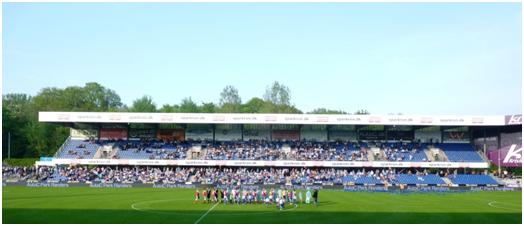
Both sides played five man midfields with just one up front. The home team using the 4-2-3-1 which now seems to be in vogue while Vestsjaelland settled for just one man shielding the back four in 4-1-4-1. The game made a quiet start, with nothing more than half chances, but Randers should have gone ahead half way through when Tidiane Sane headed over from a position almost underneath the bar. As it was, it was Vestsjaelland that opened the scoring, Rasmus Festersen playing a neat one two with Nicholas Sandberg before stroking the ball under the keeper. It really should have been two within mimutes, Sandberg pulling back a cross to Kristian Uth, who did not use the space he was given and shot wide. The set back did at least create a little urgency in the home side’s play bringing on Frank Kristensen from the bench and switching to 4-4-2 before the break. The change however looked more like panic then plan, Randers launched a series of long balls and early crosses that were easily defended. This feeling that all was not well in this part of the state of Denmark was accentuated by a quick team talk, with the home side coming back onto the field for a fresh warm up some five minutes before the second ad break of half time had even commenced. As it happened though, the rest was notas good as a change, and Randers continued to look hurried in their play. Salvation came from an unlikely source, Vestsjaelland centre half Lasse Nielsen pushed at Christian Keller, who was making a rare foray upfield. This gave Randers a free kick from a little over 20 yards, which Ronnie Schwarz curled inside the near post.
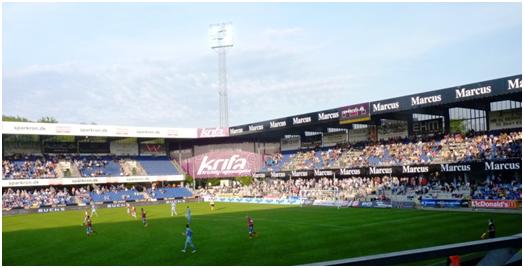
The goal calmed down the home side a little, but did not improve their competence, with crosses, (mainly from the left) proving easy for the visiting defence, who almost took the lead again a corner being delicately headed onto the top of the crossbar. With the left flank proving so troublesome, (as Randers did nothing on the right), they kept chancing different combinations, and almost made a break through when Keller cut in from the position and then back heeled to the right full back Thomsen, his cross found Sane in space, but the Ugandan did not improve his record, shooting narrowly over.
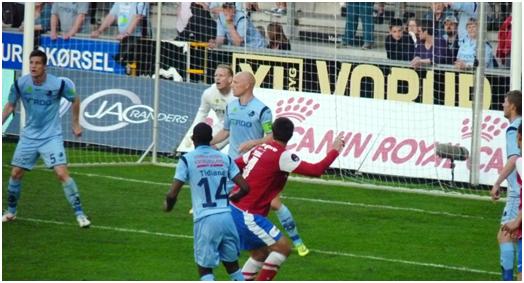
With seven minutes to go, and while waiting for a right wing cross, Randers brought on Dutchman Remco van der Schaaf, replacing the original left winger, (he had a spell on the right, and an earlier substitution replaced that left winger). Ven der Schaaf first action was to get into the centre of the box and powerfully direct a header from the corner into the goal. Defending towards the end was slightly desperate as Vestsjaelland pushed for a point they must have though they deserved, but Randers held out to take the points, establishing a six point cushion, which must put them close to securing a return to the top flight after a single season away.
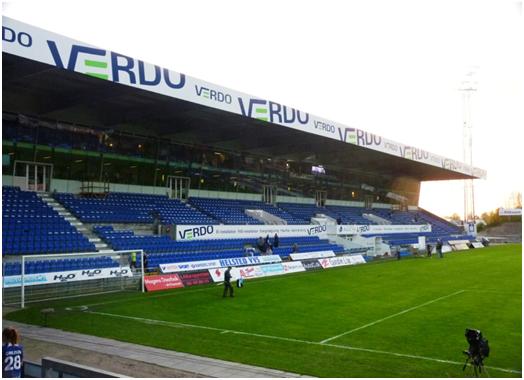
From Randers, I took the train back down to Germany, changing at the charmingly named.
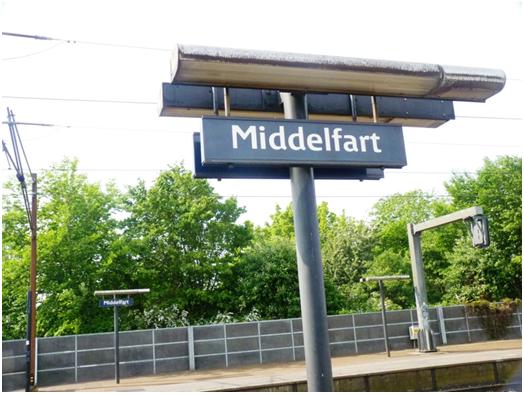
The town marks the central point of the Danish Rail Network, if not the whole country. Natuarally, I wanted to know what tourists might do here. Answer “Change Trains”, if one wants more detail, they get off trains, and then get on other trains, and hope there is not long to wait, as you are a long way from anywhere, and all the station offers is three platforms and a 7-11 shop. And what are the primary occupations of the locals? Farming, serving in the 7-11 shop and trying to ignore foreigners making cheap jokes about the place name. Now there is an idea, it had never occurred to me that I could make a cheap joke out of the name of this town.
If I find the time to write it, Tuesday will be described in Part 3 of this blog, along with other German grounds visited. Suffice to say, I returned to Denmark over land and sea the following day, making the crossing between Puttgarten and Roby on the boat train and heading into Copenhagen. Back on my first ever trip to Copenhagen, some 23 years ago, the local derby between Brondby and Lyngby was the highlighted game out of three visited, all in the top division that season. The ground was crammed with about 7,500 watching, whereas the other two games, both also in the top division barely topped 1000. For Brondby, the young Peter Schmeichal was in goal, while Brian Laudrup led the attack, but all four goals in a 2-2 draw came from Christensen. Indeed three were scored by Bent Christensen, without the requirement for own goals, both teams had a player of this name. Brondby were 2-0 up with only a few minutes to play before Lyngby’s Bent Christensen, and then Fleming Christensen scored to give Lyngby a draw. When the game finished, my travelling companions and I would have made a quick dash to Kobenhavns Idraetspark, (now simply call Parken, which was only a nickname then) to see Boldklub 1903 lose to AGF. Three years later, B1903 merged with another club sharing the national stadium, KB to form FC Kobenhavn, and the Bronby/Lyngby rivalry moved somewhat down the order of importance in Danish football.
Much of Denmark is quiet, unassuming, flat, expensive and not very interesting. It just has to be conservative, with a small c. Copenhagen is not like most of Denmark, it is chaotically busy, noisy, expensive and interesting. It is one of those cities that you need a map to explore, but you are best off keeping the map in your pocket, heading down side streets and only getting the map out when you need to find your way back to the hotel. In the summer, at least, it is an ideal cycling city and one can be stunned by the mass of bicycles on some roads or simply stunned by one as traffic regulations and cyclists never mix. It is possible that Copenhagen has more bicycles than any other European city, but it is also possible that it has less cycle helmets. I reckoned that the proportion using head protection was hardly more than 1%, which may even be less than the portion with rigged up (surely in some cases, home-made), bicycle prams attached to the front to ferry one or two youngsters around.
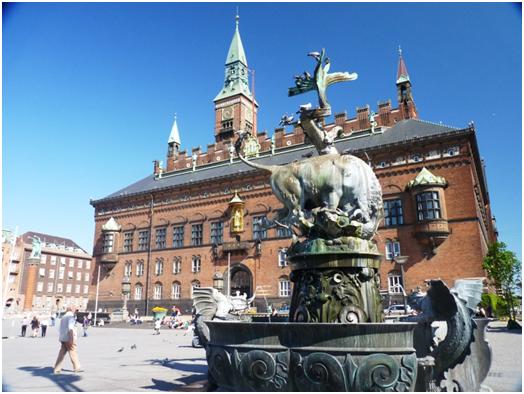
Just to make my point about the oddities behind the scenes, I cut down Vestergade, parallel to the main shopping street. At one end, this is part of the mainstream with eateries and a (rather expensive) brewpub. At the other end, there was a Goth’s fashion shop, an S&M outlet and club and a Cornish Pasty Shop. I bought (at a very reasonable price) a cup of team from one of these establishments, no prizes for discovering the proprietor had a Cornish accent.
The S-Tog (equivalent to Germany’s S-Bahn) takes you to Lyngby Station which is a mile or so from the ground, but there is a bus as well. The Stadium is well kept, but just does not look like the stadium of a club in a major European League. It is a stadium with a track, and low, single tiered stands running the full length of both sides. On the west side, where I was, the stand is mainly made out to seats, with just a small area of standing under cover at the very end. Opposite, only the central section was for seating, and this had some boxes at the back, the other two thirds were kept as standing areas. Admission at 150 DKK would, I think get you into the standing, and at least some of the seating areas. I noticed that advance booking brought the price down by 5DKK, but I did not test out the system to see if this is countered by booking charges later in the process. A free A4 programme (four pages only) is handed to you just inside the gates.
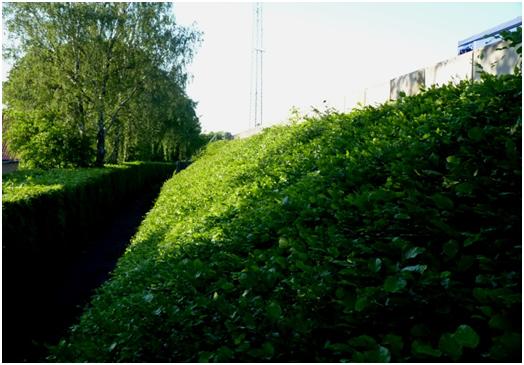
The footpath behind the main stand!!
As the viewing area curves behind the goals first of all there is a series of stepped uncovered terrace, but then this gives way to a grass bank. The steps are delineated with concrete, but the infill, normally concrete, gravel or dirt is in this case grassed and the grass has been recently mowed. And then there are the hedges. All the areas separated not by unsightly fences but by thick, green hedges. If you take the path behind the main stand, then you can hardly see the stand for the greenery. All the hedges have been kept in immaculate condition. This club does not need a groundsman, so much as a gardener.
The most popular are for home fans was the clubhouse corner where beer and sausages could be obtained while waiting for the game to get exciting. The home fans were in the opposite corner, and had been segregated. The fact that temporary catering facilities had been put into this area suggests they do not always bother with segregation. Serving the beer over the fence between the pitch and terrace helps in one regard though you are not going to invade the pitch if it means knocking over the beer supplies!
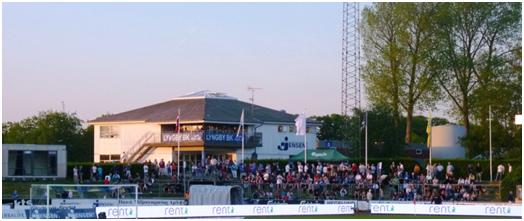
There was not a lot of excitement anyway, Lyngby should have had a chance on 19 minutes when confusion between Brondby’s goalkeeper and defender almost let in Fetai, but he could not control th e ball and ended up in a heap with the goalkeeper and defender, which the referee accurately interpreted as no foul by anyone. Lyngby did take the lead on 31 minutes, with probably the best move of the game, Thomas Rasmussen taking the ball down the left wing and slipping it inside to Anders Christiansen, who in turn threaded the ball forward to Emil Larsen to power the ball in. Larsen missed a golden chance to increase the score three minutes later, and the home team maintained their ascendency up until half-time.
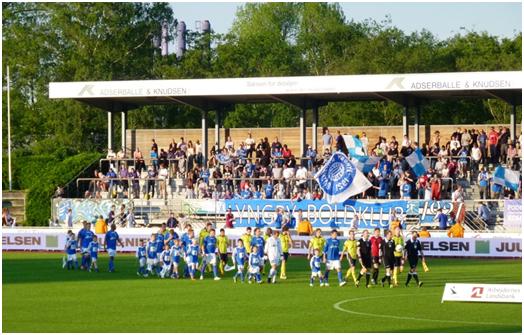
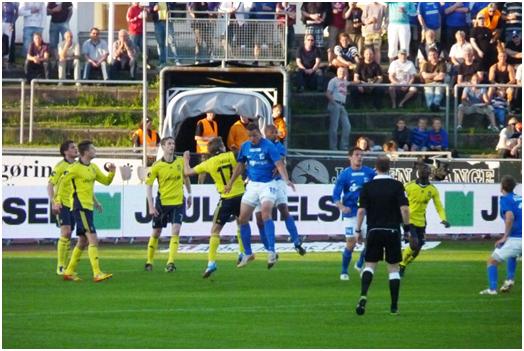
Brondby did come out for the second half trying to look a little more determined, and created a couple of half chances, but their heart did not appear to be in it. The best chance of the second half came from a free kick taken by Lynbby’s Kim Aabeck mid way through. The Brondby keeper stopped this but let it spin out of control before dropping onto just before any home forward could get onto the loose ball.

The Main stand curves slightly at the ends. The table on the left of the picture is for the sale of sausages
The Brondby fans made a great deal of noise throughout, while the home fans were generally quiet. Still, Brondby’s biggest cheer was for the news of goals at Nordsjaelland, which ensured that FC Kobenhavn were not champions. Only time will tell whether they were cheering for defeat for the team that has become their rivals, or for the eclipse of their own relevance by the new kids on the block, in the same way that FCK’s dominance has cast shadows over clubs such as Lyngby.
Lyngby, after all were the champions in 1992 when the merger created FCK. Winning the title in their first season, and playing at the refurbished Parken, FCK may have always had advantages, but they have taken time to build up support. FCK now have the biggest supporter base in Denmark (which is a reason why they are hated by other supporters), and they actually now own Parken, while Lyngby’s ground is still in municipal hands. FCK have really come to dominate since the turn of the century, winning 8 of the last 12 titles, Brondby have won two of these, but not since 2005. At least they have developed their facilities, and it now holds more than twice the crowd it could accommodate back in 1989. I visited Nordsjaelland in 1999 when they were known as Farum, and had just turned professional on joining the league’s Division 2, (third level). This was a marker in itself, as most of their opponents were not full time. It just paid off as they scraped fifth place which earned them promotion due to a reorganisation of the structures. Nordsjaelland were promoted to the top flight in 2002, and took on their current name after one season at the top level
Nordsjaelland are also using a different model to other clubs, I have been told emphatically that they did not buy the title, and in fact had only the 8th largest budget out of the 12 Superliga clubs. When they buy players, they buy cheap, but they develop most of them themselves, and through a series of more than 60 affiliated clubs in the area. Through the affiliates, known as Fodbold Samarbejde Nordsjælland (Nordsjaelland Football Co-operative), Nordsjaelland have a well run scouting network, developing players for the professional club. FCN participate in developing the training programmes, whereas the affiliates remain independent.
Overall, Danish Football is in a much better state than it was when I first watched a few games. The crowd of 1988 that watches the Lyngby game was a low figure, highlighting the lack of importance of the games. Three of the games on the last night had crowds over 10,000 with almost 20,000 at FC Kobenhavn. Denmark have been moving up the UEFA co-efficient table (club performance in European competitions), and are now ranked significantly higher than Scotland (hence two Champions League places, and less qualification to reach the group stages). While Denmark’s 1992 Euro success was based on players playing abroad, they now have a much greater number of their best players back in their homeland. TV money has proved the catalyst for this, but the knowledge that Denmark is not a footballing backwater, (if not yet in the European Premier League), has led to increased crowds, and their has been a rash of ground improvements to accommodate them.
Lyngby, who fell into bankruptcy in 2002, despite climbing back from non league football with promotions in 2003, 5, and 7 (and 2010 following relegation in 2008) have not been a beneficiary of the boom, and Brondby’s fans will find their cheering of Nordsjaelland success to be ironic if they too are consigned to the shadows.
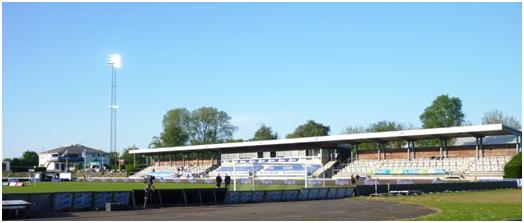
And so to Sweden, making use of their fixtures being spread over Wednesday and Thursday. 4 on each in the Allsvenkan which translates as All Sweden and is the National League. The second division in Sweden is called the Superetten. The first division, which is regionalised North and South has never been a National League, and since the National League started, it was the second level, until the Superetten started in 2006, (basically as Allsvenkan II). There is a direct train from Copenhagen to Halmstad which using the new bridge takes around two and a half hours. I then had two hours to book into a hotel and freshen up before travelling on. The trouble was that the “hotel” I was staying in also refers to itself as a “Hostell”, and uses that as an excuse not to have 24 hour service. In fact the only check in times were 4-7 in the afternoon, during which I was to be either travelling or at the ground. Fortunately, after a quick phone call, I found out I could leave bags there and get my key later from a key safe. Two trains were required to get me up to Borås, home city of IF Elsfborg, a short ride on the main line, followed by over an hour on a branch (ran by a different company). Even the main line has single track sections, and the 30 minute ride took over twice that. Fortunately, I had allowed a margin of error, getting the next train to Borås and staying on it for one extra station to Knalleland. Maps show a complicated road lay out between the station and the ground, but actually, it is all part of a retail park, and you can simply walk straight across the car parks, completing the journey in about five minutes.
When it was completed in 2005, the Borås Arena was the first modern ground in Sweden. IF Elfsborg celebrated moving in by winning the Swedish title for the fifth time a year later. It had been 45 years since they last won the title. Since then they have maintained a challenge, but the sixth title has so far eluded them. After 11 rounds of this seasons, Elfsborg are top, six points ahead of Malmo, but it is a 16 team, 30 game season. The only other time I have seen Elfsborg play, it was away at Halmstad in2003, with Halmstad then league leaders, but Halmstad did not go on the win the title, (they last won in 2000). The Swedish League is now considered one of the most open in Europe, with the last seven titles going to seven different teams, Djugårdens, Elfsborg, Göteborg, Kalmar, AIK, Malmo and Helsinborgs. The visitors to the Borås Arena, BK Häcken started out in third place, and are the highest place team who have never won the title.
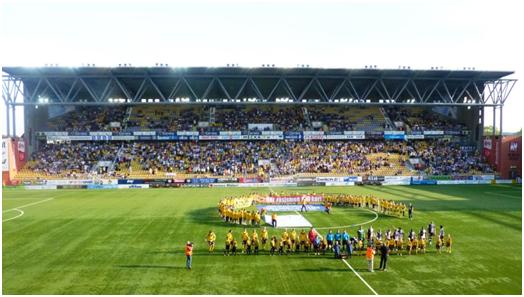
Pesentation of teams before kick off. Even though it is an artificial surface, it needs maintenance, and was being watered before kick off. As the kids (in centre circle) were entering the playing area, with their “Give Racism the Red Card” banner, one of the automatic sprinklers started up, giving many of them an impromptu soaking.
The Boras Arena is a square ended stadium with an up to date artificial surface. There are two tiers of seats along the long sides, and single tier stands behind the goals. I think these are supposedly all seats, but there is an fact a mix between proper seating and benches, with most preferring to stand in the benched areas. It is of goalpost type construction with a lattice at the front of the roofs supported by steel post, but no blockage of the viewing lines. The lattice is below the roofs to the side, but above the ones behind the goal, allowing it to also support giant monitor screens. The Ryavallen, which the Arena replaced is next door to the north and is now used mainly for Athletics. It’s main stand almost backs onto the north stand of the Arena, with a section between the two roofed off, allowing covered access at the main entrance to the Arena.
The Arena itself is shared with Norrby IF, a club two levels below Elfsborg who also used to play at Ryavallen. It is owned and operated by an investment company, with IF Elfsborg as a major shareholder. IF Elsborg were founded in1904 as Borås Fotbollslag, but changed their name two years later, “because too many teams included Borås in their name”. One hundred years later, no major team appears to have Borås in the name.
Most of the seats in the main stands sell at 250 SKR, with tickets behind the goal available at 140 SKR. The programme, which costs 20 SKR is pocket sized, and unfolds to the equivalent of ten pages. It also serves as a 50/50 lottery ticket, that is to say half the proceeds are a lottery prize.

Elfsborg, playing a 4-4-2 formation and a team that is 100% Scandinavian, (one Dane, one Norwegian, nine Swedes), got off to the perfect start with a goal after just six minutes, Stefan Ishiaki took a free kick out on the left wing, and it went through a crowd of players, probably just getting a slight flick of deflection on its way into goal. This should have suited them through the half, as they allowed Häcken the majority of the possession, and then when they picked up the ball from defence they fired a long ball to one or another wing, or through to the forward. Certainly they appeared to be the more likely to score again before the break, at least until BK Häcken really should have levelled things on 39 minutes. Häcken were playing 4-3-3 with all three of the forwards being African imports Majeed (Ghana), Chatto (Nigeria) and Makondele (DR Congo). The team maintained a tactic that was simply, “get the ball to the Africans”, after which the 8 Swedes tended to stand and watch. For this, the closest they came to the goal, Majeed actually started things by robbing a defender near the edge of the area, chasing for possession and then passing to Makondele. Makondele exchanged passes with Chatto, which left him with only the goalkeeper to beat, or as it happened, time for a soft punt into the goalkeepers surprised arms.
AT each end of the stadium were giant screens which showed the match as it was going on, with action replays of non-contentious decisions (generally near misses by the home team were replayed, fouls were not). They also relayed every goal from other matches being played in the Allsvenkan that evening, which did not appear to add up to many interruptions, and gave us updates on the odds for our game 15 minutes in, betting on the game staying 1-0 would have earned one a return at 10-1, by 15 minutes into the second half, it had dropped to 2.5.
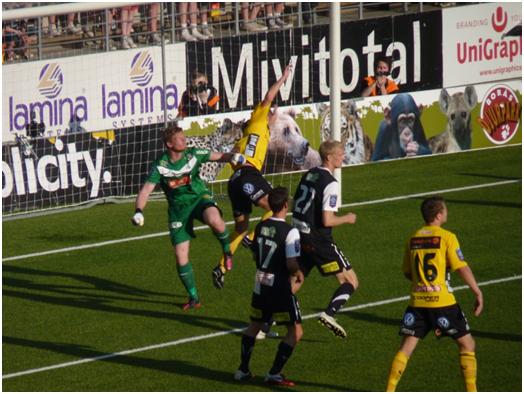
The trouble was that although there was plenty of attacking play, it was very one-dimensional, with no alternative plans on offer. Elfsborg prefer to defend in depth and then launch long balls forward as soon as they get possession. Their opponents were also strangers to the art of patient build up. Elfsborg’s approach should have paid off in the 72nd minute, when a rare defensive error meant the long ball game had left Elfsborg’s Lasse Nilsson with a run at goal, he was quick, but inaccurate with his shot, so instead dived over the keeper. This one at least did not fool the referee, and Nilsson received a yellow card for his efforts.
Still, diving is a tactic worth trying if you only get a yellow card 50% of the time, when Niklas Hult found himself as the only home player in the opponents half on receiving a long ball 8 minutes later, he evaded the first challenge, but as soon as he entered the area (with no one close to being a potential target for a pass anytime within the ten minutes still to play), he made contact with the challenge and then went to ground in much the same way as a brick does, if you drop it from six feet. For reasons I never fathomed, the referee did not book Hult as well, but instead awarded a penalty. Nilsson converted, which at last confirmed the wisdom of not taking offers at 10-1 for 1-0.
It should have been more, Chatto received his second yellow card just as the injury time board was displayed, and in the four minutes of injury time, both Ishizaki and Hult contrived to miss chances for Elfsborg.
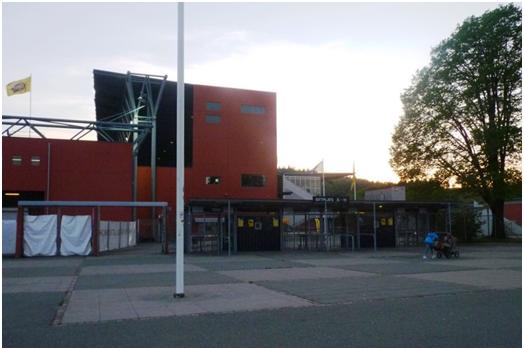
From the outside, the Norh stand, and you can see the back of the adjacent Ryavallen’s stand
From there, it was just the matter of getting back to Germany, with a very brief overnight stay in Halmstad, and then onto Copenhagen and Hamburg. This last train was problematic. I think the Germans do not like sending their best trains or staff to Denmark. The train out of Copenhagen was overcrowded due to Danes heading to a game in Hamburg, and noisy as not surprisingly, an international in Hamburg is an excuse for much beer to pass through Danish supporters. The train lacked indication of seat reservations, as the electronics for this was not working, leaving a lot of passengers taking seats only to be moved on as others got on with reservations, and of course not knowing whether the seat gained, (the one I am typing from) would be lost to a passenger getting on down the line.
The fault also meant there was nothing either hot or cold in the buffet car. The steward made a point of showing me a melted twix bar, but could not offer sandwiches, coffee or chilled drinks. Its over two hours from Copenhagen to Roedby, where the train enters the ferry. One has to hope that the Danes’ supplies of canned Carlsberg last out until they can get more supplies.